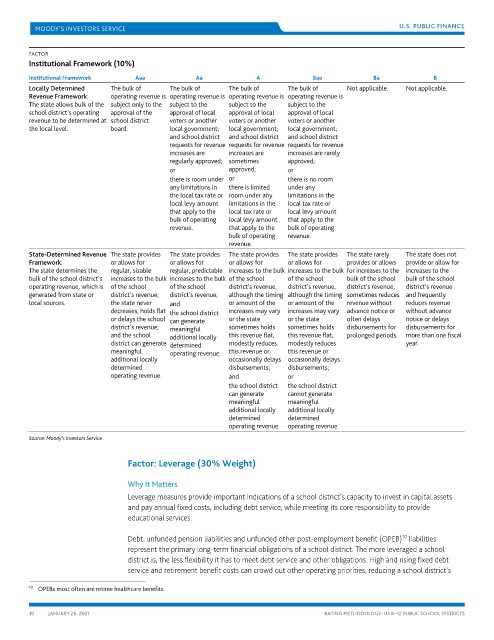Page 1644 - draft
P. 1644
U.S. PUBLIC FINANCE
FACTOR
Institutional Framework (10%)
Institutional Framework Aaa Aa A Baa Ba B
Locally Determined The bulk of The bulk of The bulk of The bulk of Not applicable. Not applicable.
Revenue Framework: operating revenue is operating revenue is operating revenue is operating revenue is
The state allows bulk of the subject only to the subject to the subject to the subject to the
school district’s operating approval of the approval of local approval of local approval of local
revenue to be determined at school district voters or another voters or another voters or another
the local level. board. local government; local government; local government;
and school district and school district and school district
requests for revenue requests for revenue requests for revenue
increases are increases are increases are rarely
regularly approved; sometimes approved;
or approved; or
there is room under or there is no room
any limitations in there is limited under any
the local tax rate or room under any limitations in the
local levy amount limitations in the local tax rate or
that apply to the local tax rate or local levy amount
bulk of operating local levy amount that apply to the
revenue. that apply to the bulk of operating
bulk of operating revenue.
revenue.
State-Determined Revenue The state provides The state provides The state provides The state provides The state rarely The state does not
Framework: or allows for or allows for or allows for or allows for provides or allows provide or allow for
The state determines the regular, sizable regular, predictable increases to the bulk increases to the bulk for increases to the increases to the
bulk of the school district’s increases to the bulk increases to the bulk of the school of the school bulk of the school bulk of the school
operating revenue, which is of the school of the school district’s revenue, district’s revenue, district’s revenue, district’s revenue
generated from state or district’s revenue; district’s revenue; although the timing although the timing sometimes reduces and frequently
local sources. the state never and or amount of the or amount of the revenue without reduces revenue
decreases, holds flat the school district increases may vary increases may vary advance notice or without advance
or delays the school can generate or the state or the state often delays notice or delays
district’s revenue; meaningful sometimes holds sometimes holds disbursements for disbursements for
and the school additional locally this revenue flat, this revenue flat, prolonged periods. more than one fiscal
district can generate determined modestly reduces modestly reduces year.
meaningful operating revenue. this revenue or this revenue or
additional locally occasionally delays occasionally delays
determined disbursements; disbursements;
operating revenue. and or
the school district the school district
can generate cannot generate
meaningful meaningful
additional locally additional locally
determined determined
operating revenue. operating revenue.
Source: Moody’s Investors Service
Factor: Leverage (30% Weight)
Why It Matters
Leverage measures provide important indications of a school district’s capacity to invest in capital assets
and pay annual fixed costs, including debt service, while meeting its core responsibility to provide
educational services.
10
Debt, unfunded pension liabilities and unfunded other post-employment benefit (OPEB) liabilities
represent the primary long-term financial obligations of a school district. The more leveraged a school
district is, the less flexibility it has to meet debt service and other obligations. High and rising fixed debt
service and retirement benefit costs can crowd out other operating priorities, reducing a school district’s
10 OPEBs most often are retiree healthcare benefits.
10 JANUARY 26, 2021 RATING METHODOLOGY: US K–12 PUBLIC SCHOOL DISTRICTS

